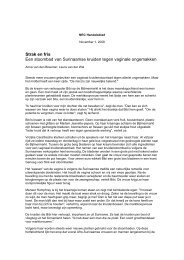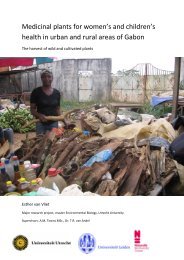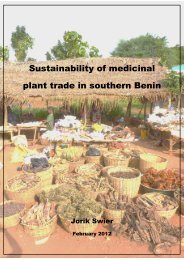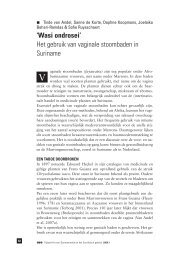T. Heilbron 2012.Botanical relics of the plantations - osodresie
T. Heilbron 2012.Botanical relics of the plantations - osodresie
T. Heilbron 2012.Botanical relics of the plantations - osodresie
You also want an ePaper? Increase the reach of your titles
YUMPU automatically turns print PDFs into web optimized ePapers that Google loves.
(a) Relics <strong>of</strong> a historical<br />
tamarind lane on plantation<br />
Alliance, Commewijne<br />
3.2 Detailed examples<br />
3.2.1 Amerindian <strong>relics</strong><br />
(b) Cactus <strong>relics</strong> in a hedge in<br />
a swamp forest on plantation<br />
Barbados, Commewijne<br />
Figure 5: Images <strong>of</strong> <strong>relics</strong><br />
(c) Thick mango individuals and<br />
roots on plantation Berg en Dal,<br />
Brokopondo<br />
A collection <strong>of</strong> a bush pepper native to Suriname (Capsicum annuum var. glabriusculum) was<br />
made at <strong>the</strong> abandoned plantation Bent’s Hoop. The vernacular name ‘pepper <strong>of</strong> God’ was<br />
explained by a Javanese elderly woman who heard from her fa<strong>the</strong>r that <strong>the</strong> pepper ‘cannot be<br />
planted by humans, only by God’. On <strong>the</strong> nearby abandoned plantation Kerkshove, Bixa orellana,<br />
used by Amerindians (and African slaves) for its red dye (Ostendorf, 1962), was found<br />
growing wild.<br />
3.2.2 Cash crop <strong>relics</strong><br />
Numerous cacao trees stand in <strong>the</strong> rainforest at <strong>the</strong> former plantation Montpellier, abandoned<br />
since 1840. Locals identified <strong>the</strong>se trees as being from <strong>the</strong> plantation era and indicated <strong>the</strong><br />
variety <strong>of</strong> <strong>the</strong> cacao as one formerly used, but not in recent times (although this could not be<br />
confirmed by <strong>the</strong> literature). A remnant <strong>of</strong> a cacao field was also found at plantation Berlijn.<br />
However, ra<strong>the</strong>r than a remnant <strong>of</strong> <strong>the</strong> plantation era, this was a remnant <strong>of</strong> a field established<br />
after <strong>the</strong> Second World War. After a few bad harvests, ownership changed and currently <strong>the</strong>se<br />
<strong>plantations</strong> are in use for o<strong>the</strong>r agricultural practices such as cattle farming. Remnants <strong>of</strong> cacao<br />
and c<strong>of</strong>fee fields were found on plantation Peperpot, where production stopped a few decades<br />
ago.<br />
11










